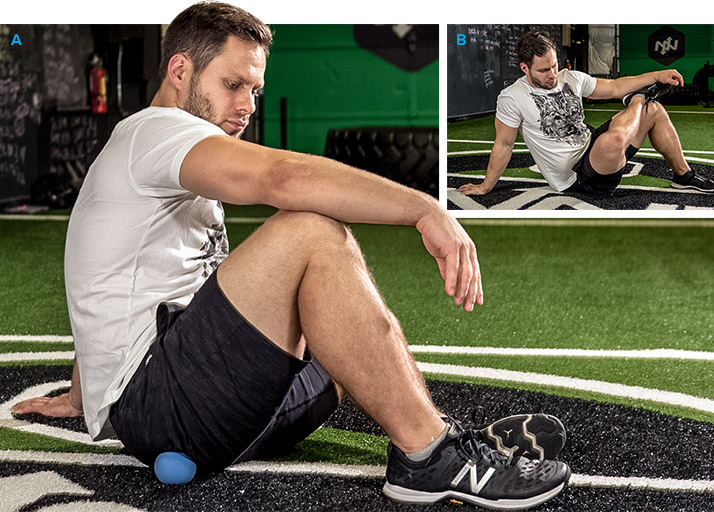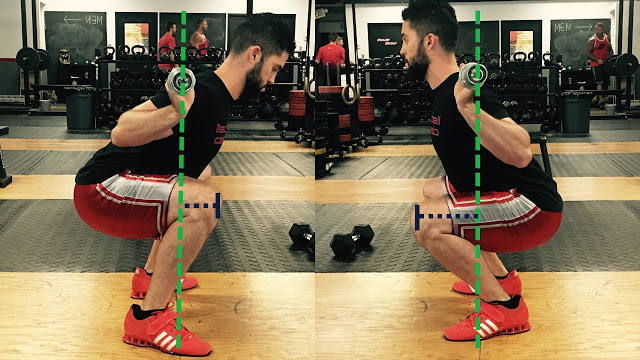“NO REP!,” “Drop your hips lower!” “Not deep enough!” “Keep your heels on the ground!”
If you’re an athlete and are constantly hearing these cues from your coach, you’re probably not hitting a full depth squat. Unless you’re intentionally sacrificing range for reps, you’re also probably tired of explaining that you physically can’t squat any lower without falling over.
Maybe you’ve even tried to work on your mobility- spending 20 minutes on the foam roller or stretching your hip flexors without really making any lasting progress in your squat mobility. If you’re trying to figure out how to adopt a more individualized approach to addressing your squat depth, this post may be your new favorite resource.
Maybe you’re on the other side of this coin-maybe you’re a coach, a physio, or any other movement specialist with those depth cues always the tip of your tongue on squat days (or wall ball days, cleans, snatches. . . ). Four years ago as a new CrossFit coach, I would constantly find myself yelling squat depth cues over the music toward my athletes, and shaking my head when they would nod understanding and proceed to squat to exactly the same depth.
The ever-elusive full depth squat is a stumbling block for many newer and even some seasoned CrossFit athletes. Unfortunately, it’s a movement that can significantly impact performance when it’s not there, especially during the Open (avoiding no-reps), and in competitions across the country that have started to program the “use your remaining time to find a 1RM snatch/clean” after an already exhausting WOD-- 18.2a anyone? It’s tough to maintain enough hip speed to use a power snatch/clean in these scenarios, so why not let gravity help you get under the bar and then stand up the squat? Easier said than done for people who can’t yet drop into the bottom of their squats.
Unfortunately, better squat mechanics/depth are almost never achieved in a WOD, but rather reveal themselves as a result of a targeted assessment, individualized coaching or mobilization, and mindful repatterning of movement.
So what can you do about your squat?
Barring any nagging pains or injuries that may be limiting you from living your best life in the bottom of your deepest squat, below are five common limiters that I see in athletes as well as ways that you can assess and target each issue:
Poor ankle mobility
Poor hip mobility
Quad Dominance
Poor Thoracic Mobility
Motor Control
Check yourself out and get started on your journey toward squat nirvana. Continue reading for ways to self-assess your mobility. Of course, if you do find yourself in the “nagging pains or injuries” category, make an appointment with your local rehab professional to get assessed!
Below are ways to test or assess your limiters, and address them accordingly with mobilization. There is only ONE rule for mobilizing:
USE YOUR NEW RANGE IMMEDIATELY following your favorite mobilization!
We know that the effects of mobility exercises usually only last a short time (a few hours max) unless we take purposeful steps to make them permanent by LOADING and strengthening that new range. If you notice improvements after trying any of the exercises, immediately perform 1-2 minutes of ANY squat that you’d like with a kettlebell and hang out in the bottom for at least 2 seconds on each one. Better yet, perform a few of your squats only between half and full range, fully standing up ONLY after around 10 reps are completed .
1. ankle mobility
The ankles seem so far from the hips, but are in fact, crucial to squat depth! You might be in this category if…
you have a history of ankle sprains
you squat significantly better in lifters than in flat shoes
you squat deeper with a kettlebell in your hands than without
you feel like you’re falling backward at the bottom of your air squat
your shins burn when you hold the bottom of a squat
your foot (feet) turns out at the bottom of a squat (duck foot)
ASSESS: With a flat foot, how far away from the wall can you step and still tap your knee to it? Your knee must be tracking over your second toe for this to be accurate. You should aim for at least 4” (index card) away from the wall to pass this test!
Didn't do so hot?
ADDRESS: My two favorite ankle mobilizations are the banded dorsiflexion with assist (1) and an active muscle release (2). Give them a try!
(1) Banded DF with assist. Relax into the band's pull to let your knee travel over your toes.
(2) Active muscle release. Find a tight spot at the back of your ankle/calf and draw some circles with your foot to loosen up any tightness you're feeling!
RETEST :
Check your foot distance from the wall again….better? Fantastic! IMMEDIATELY alternate the mobilization with sets of your chosen squat.
Not better? Give it a few sessions. Then try something else! For more on ways to mobilize your ankle, check out this post from CrossFit Invictus .
2. hip mobility
Hips are everybody’s first scapegoat for their squat depth ("My hips are always so tight!") but not always the true limiter.
You might be in this category if…
you feel pinching in the front of your hip when you squat
you have difficulty with pigeon and/or hurdler positions
you have clunking in your hip
you were a ballerina/gymnast
you have a lot of muscle or other soft tissue mass
ASSESS:
While you're laying on your back, are you able to pull each knee to your chest? If not, are you at least able to pull it past 90 degrees keeping your back flat on the ground? This would be a squat below parallel! Play around and find a hip angle allows you to pull your knee the furthest- try bringing your knee out to the side rather than straight toward your head. Then, setting your hips in that comfortable angle on all fours, sink your hips back toward your heels without rounding your back too much.
Knee to chest: can you pull your thigh past vertical?
Quadruped rock back
ADDRESS:
Banded Squat Mobilization: Try strapping a band to the rig to pull your thigh back and to the side while you perform some air squats.
Muscle release: If your glute (booty!) muscles feel tight, sit down and place a lacrosse ball underneath the outside of your thigh. Move some body weight over the ball using your other leg and arms for support.
Band setup and positioning. From here, stand up then drop into your squat.
Muscle release: Rotate your leg for an extra challenge.
RETEST:
Perform the hip test that was most limiting. Is it more comfortable? Try your air squat again. More mobile? Now LOAD YOUR NEW RANGE with some weighted squats. If you are getting painful pinching at the front of your hip with any of these exercises, check out the link below for information on hip impingement.
3. Quad dominant patterning
For all the quadzillas out there.
You might be in this category if…
your hamstring and glute size don’t quite match your massive quad development
your coach keeps telling you to “hinge at the hips”
you feel pressure in the front of your knees during your descent and pressure in your toes/calves during the ascent
your torso stays mostly upright during your squat
ASSESS:
Take a video of yourself! Do your knees move forward before your hips move backward? Is your torso mostly upright? Do your hips shoot backward when you initiate your ascent from bottom of your squat? Compare yourself to the image below from Barbell Rehab. Are you more similar to the picture on the right? If you answered yes to any of these questions, your over-reliance on your quads might be limiting your squat!
ADDRESS:
Revisit your hip hinge by going back to the dowel and re-pattern your squat to initiate with your hips rather than your knees.
Add in barbell hip thrusts to your accessory work to strengthen glutes!
RETEST:
Try initiating your squat with your hips and reaching your tailbone back behind you during squat. Are you able to squat deeper? If so, drill this pattern. Then add weight and LOAD the pattern.
4. thoracic mobility
Limitations here are often found in newer CrossFitters who haven’t yet spent hours doing T-spine extensions.
You might be in this category if…
you work at a desk and don’t move much (yet!) during the day
your upper back doesn’t move well over the top of a foam roller
your upper back side profile looks rounded even when you try to arch backward or press overhead
you need a good upper back crack more than once a week
ASSESS:
Grab your phone or a friend so that you can film yourself from the front. Move onto the floor on all fours with your knees slightly out to set up for a rock back T-spine rotation. Rotate as far as you can upward with your upper body while your hips stay down on your heels. Look for your collarbone elevate to at least 45 degrees above horizontal.
Rock back T-spine rotation: how far can you go?
ADDRESS:
As it turns out, rotation is an indirect measure of your ability to extend, or straighten, through your upper back, so the first exercise is to simply perform multiple rotations on all fours. You can also use T-spine extensions over a foam roller.
To really cement this pattern, perform some banded rows at the bottom of your squat position!
RETEST:
Take a second video. In your rock back position, can you rotate further than the first time? Perform your squat again, has your depth changed? Does it feel better? Drill the pattern and then LOAD your squat.
5. Motor Control
When we don't have enough stability in certain positions, our body can prevent us from going into these positions by tightening certain muscles up. You might be in this category if….
you’ve passed all of the above screens with flying colors and still don’t have a full depth squat
your coach tells you to “pull your ribcage down; close your bowls; arching your back”
you have back pain
you can do a full depth air squat, but not a full depth barbell squat
you have experienced incontinence (leaking urine) during jumping, squatting, deadlifting
ASSESS:
Disclaimer: this one may be difficult to assess without a trained eye. I've provided suggestions, but you may want to get assessed by your coach or a professional to clean up your patterns, especially if you've ever experienced incontinence while lifting (common, but not normal)!
You can take a video of the side profile of your squat: Does your ribcage flare out in front? This is not efficient! Is your upper back rounded? Also inefficient. Can you straighten it out? Good! Does your upper back collapse or round under heavier weight? Possible weakness!
Try a hollow hold: are you able to maintain your low back on the ground and ribs tucked while you move your arms and legs in different directions? If not, you might need to work on your bracing and motor control of your core! (Check out this post.)
ADDRESS:
My favorite way to get athletes more comfortable and confident in various positions of the squat is training the "three breath pause squats." This is best practiced first with a goblet squat, but can be progressed with barbells as well.
The goal is to exhale to pull the rib cage down before descending into a quarter squat. Another breath is taken with an exhalation and ribs down before descent into the half squat. The last breath is taken before descending from half into full squat so that the ribs are again locked into a strong position to support weight and maintain pressure.
RETEST:
When you focus on your breath, are you able to obtain a deeper squat? Or do you feel more stable in any position of your squat? If so, keep working this pattern and LOAD it with progressively heavier weight without losing your rib positioning.
Squat often, Squat deep :)
Marissa Rescott, SPT, CF-L1
The Ohio State University '18
Marissa is a Doctor of Physical Therapy student and CrossFit coach who is completing a specialized 6-week internship experience with ArrowPT before she graduates with her license in May. She is focusing on learning the elements of a successful cash PT practice, conservative treatment strategies for hip impingement, and injury rehabilitation for the CrossFit population. Marissa describes herself as a neuro nerd, lunge lover, and adventurer who believes in the benefits of one-on-one care to return her patients to an active lifestyle!










